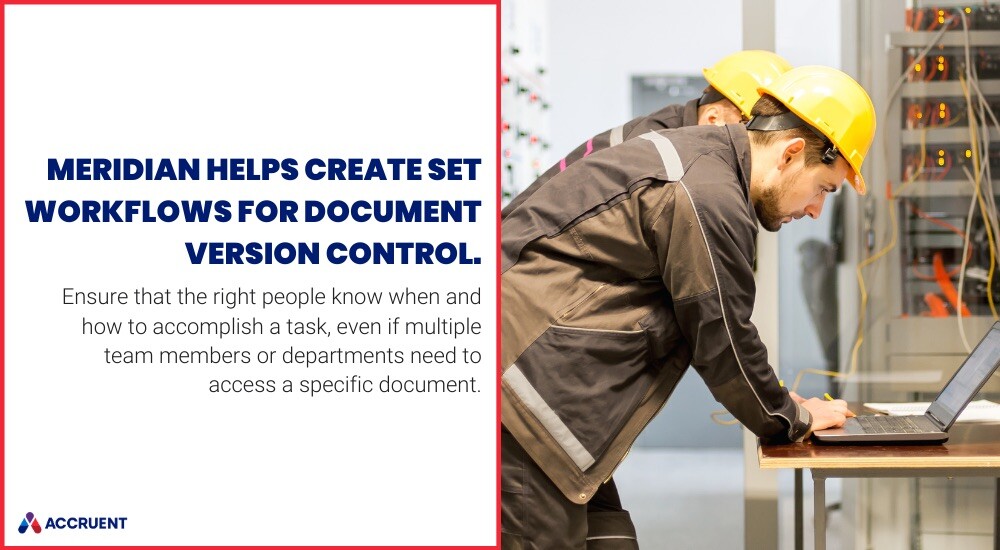
How the IoT Impacts Maintenance Management
IoT will continue to have a massive impact in the maintenance management field - and it's a technology that you shouldn't sleep on.
Solutions
Resources
Browse our full library of resources all in one place, including webinars, whitepapers, podcast episodes, and more.
Support
Looking for access to technical support, best practices, helpful videos, or training tools? You’ve come to the right place.
About Accruent
Get the latest information on Accruent, our solutions, events, and the company at large.

Explore the history of document version control, benefits, common execution barriers, and recommendations to ensure the greatest success.
If you’re not prioritising comprehensive document version control, you’re compromising the effectiveness of your engineering tools and operations, which could be costing your business money and efficiency.
Why? Without effective document version control, your employees and decision-makers can wind up acting on information that is out-of-date, incomplete, or missing across individuals and departments — and this can lead to significant financial and efficiency concerns.
And this problem is more common than you might expect, particularly in organisations that operate with manual or legacy systems. Here’s how to ensure effective document version control to uphold the integrity of documents, increase productivity and make good use of your relevant data.
The document storage and version control process has undergone several evolutions in recent decades. Originally, documents were updated and stored manually using pen, paper, and filing cabinets. It was straightforward and simple but messy and inconsistent. Formatting varied depending on the document and the user, the process was prone to human error, and companies often faced incomplete or hard-to-find information.
Then there were the first online document storage systems: complex systems that were often hard to update and faced issues like low user adoption, poor integrations, and difficulty uploading and storing files. In some ways, these made document storage and document version control even more difficult. Some information was still on paper; some were in the system correctly; some were partially uploaded but incorrectly formatted — the list goes on.
In all instances, the inefficiency and inconsistency often led to significant consequences, including:
Then, robust engineering document management systems (EDMS) began to emerge. These systems offer more precise document management in an easy-to-use, well-integrated, and highly adopted system.
Overall, a modern EDMS will:
That said, this will only work if your EDM system is highly adopted, easy to access, simple to integrate — and conducive to effective document version control.

Automatic document version control and auditing help ensure that all versions and drafts of a document are accurately recorded and managed across team members and devices. This type of content management can lead to significant benefits, including:
The right document version control system will allow you to easily access a previous version of your documents and projects, which can help guard your important information in the case of computer crashes, mistakes, or data loss. It can also allow you to see who edited particular documents and which can help your team better track and manage file changes.
Effective document version control software allows multiple people to work simultaneously on a current version of a document or project without a document going out of date or edits interfering with another person’s work. One team member can also access a working copy for document revision across locations and devices.
This version management prevents team members from working on out-of-date or multiple versions while decreasing delays that would come with only one person working on a document at a time.
Without access to up-to-date engineering drawings and documents, utility professionals often struggle to collaborate within and with other departments. Additionally, they can also encounter increased difficulty remaining compliant with regulatory bodies.
Document version control resolves this concern by helping team members organise important compliance information and letting them easily access relevant documentation.
Various stakeholders, contractors, and engineers involved in a project can make it difficult to uphold the integrity of the engineering data at hand. Without document version control software or an EDMS, it’s also difficult to search for documents and drawings. In fact, on average, maintenance, engineering, and operations teams spend roughly two hours a day searching for accurate and up-to-date engineering information.
Using an EDMS with document version control, all users can access up-to-date, accurate information, which ultimately helps maximise productivity, save time, increase safety, and ensure data integrity.
Just because document version control has benefits doesn’t mean that it’s easy to execute. Many businesses today run into common roadblocks when trying to effectively manage document version control:
Mobile, multi-site and remote capabilities are essential to effective document version control — and, more broadly, to effective multi-site operations. This is particularly important in a post-coronavirus context. That said, many companies run on systems that are:
This makes mobile agility impossible, ultimately hindering effective version control and its benefits.

In many industries, including utilities and manufacturing, companies often work with disconnected and largely manual legacy systems. Though many don’t see this as a concern because it’s “how they’ve always done things,” these legacy systems can become a particular hindrance in the context of COVID-19 and given the modern onslaught of data that most businesses have faced in recent years. They can also make effective document management nearly impossible.
Adoption itself can be a significant barrier to effective document version control, and it’s a common concern, particularly if:
And poor adoption can render a system ineffective since it causes the very out-of-date, incomplete, and inconsistent document information that EDMS systems are deployed to avoid.
For document version control to work, your business must establish clear standard operating procedures (SOPs) that will govern your version control practices. This helps ensure consistency when inputting information, obtaining approvals, and finalising documentation. Effective SOPs can also help easily obtain ISO certification.
That said, many businesses don’t have well-developed SOPs or clear workflow processes, which can ultimately create inefficiencies and inconsistent process outcomes.
After implementation, a dedicated EDMS administrator can help you maintain your documents and your EDMS system. This individual can be responsible for:
This person can also help your organisation avoid the mistakes listed above, ultimately saving money and increasing your operational effectiveness.
If you want to execute document version control effectively, it’s vital that you keep a clear document history outlining any changes you made, when they were made, and who made them. This versioning capability can help you gain transparency about your current version while also allowing you to revert to previous document versions whenever necessary.
Similarly, the right EDMS will allow you to “check out” an electronic document, thereby providing revision control and locking it against further edits. This can help safeguard documents against unapproved changes while preventing unnecessary revisions and the development of inaccurate versions.
All your documents should have clear controls regarding who can access them, who can edit them, and what edits each team member can make. For example, an important safety document should only be edited by qualified personnel.
In the same vein, you can also enable notifications, so key team members are alerted when changes are made (I.e., when a document is edited or approved).
Meridian can ensure that the right people know when and how to accomplish a task, even if multiple team members or departments need to access a specific document. For example, during a motor assembly project, various engineers might have to review the integrity of the motor designs and updated wiring. Meanwhile, someone from fabrication might have to ensure that the right machinery is available to complete the project.
Workflows in Meridian can inform all relevant users of their responsibilities while automating key tasks like:
That way, organisations can keep their master data up to date while coordinating their change processes in isolated work areas with workflows. This can ensure data validation and provide a complete audit trail for regulatory compliance.

If you want to make version control work, ditch the legacy systems, and opt for an easy-to-integrate, modern EDMS that allows you to access and edit documents from a computer, tablet, or mobile phone.
Make sure that your system has security features in place like encryption to ensure that your documents are always safe and private. Also, make sure that you have a proper backup system — possibly in the Cloud — to avoid data loss or system crashes.
Connect to relevant systems so you can access and reference important documents. For example, maintenance and operations departments often store most of their asset-related information in a computerised maintenance management system (CMMS).
You can connect Meridian’s EDMS software to your CMMS to break down information silos, develop comprehensive insights, increase document security, and ensure your asset information is accurate throughout the asset lifecycle.
Similarly, you can use Meridian to store, manage, render, and visualise the 2D and 3D content from your other CAD software systems. You can also develop references and relationships between your documents to easily organise and locate your CAD documents, such as piping and instrumentation diagrams (P&IDs). More specifically, all document references are readily available within Meridian EDM software, including project copies, equipment tags, and functional locations.
This can sync all relevant information, providing the necessary visibility to effectively use drawings and carry out a task.
Finally, it’s important to make sure that all teams involved in your projects — including external contractors — have access to the information they need. This not only ensures that field changes are accurately conveyed but also streamlines communication when there are many projects happening at once.
Using Meridian, you can easily send documents to contractors to view, update or augment as necessary. Additionally, the tool allows for automatic validation of CAD software file references and a full audit log of all actions so you can always maintain accountability and visibility into changes.
Want to learn more about document version control and other capabilities in Meridian EDMS? Schedule a demo.
IoT will continue to have a massive impact in the maintenance management field - and it's a technology that you shouldn't sleep on.
Optimise space management with data-driven insights. Maximise data efficiency, reduce costs, and stay competitive with smart tech solutions and key ...
Our helpful guide covers everything you need to know about construction project management tools, including their advantages and how they can work ...
Subscribe to stay up to date with our latest news, resources and best practices